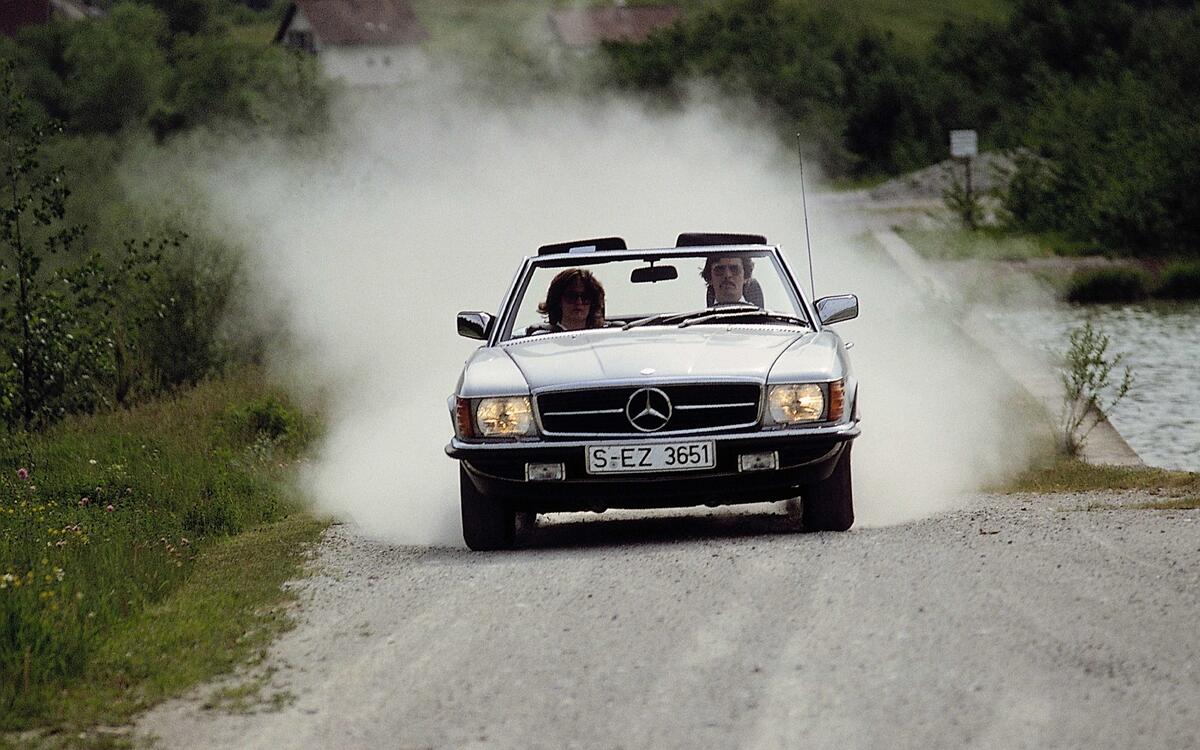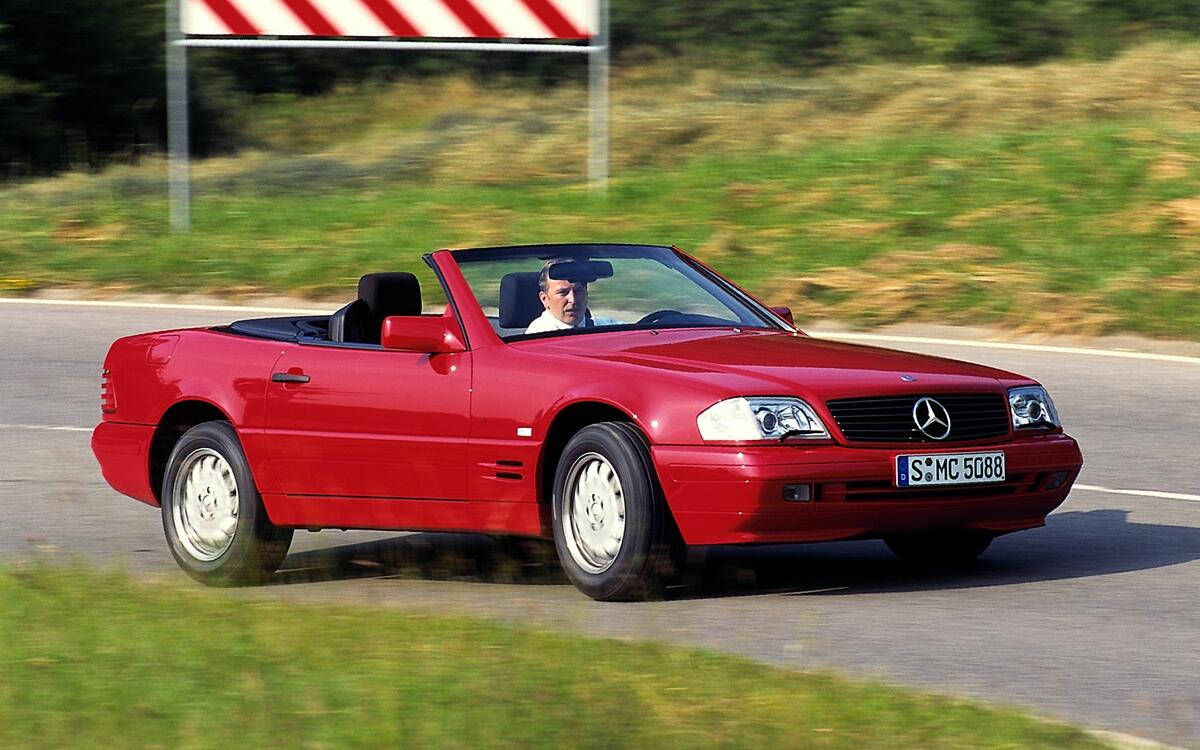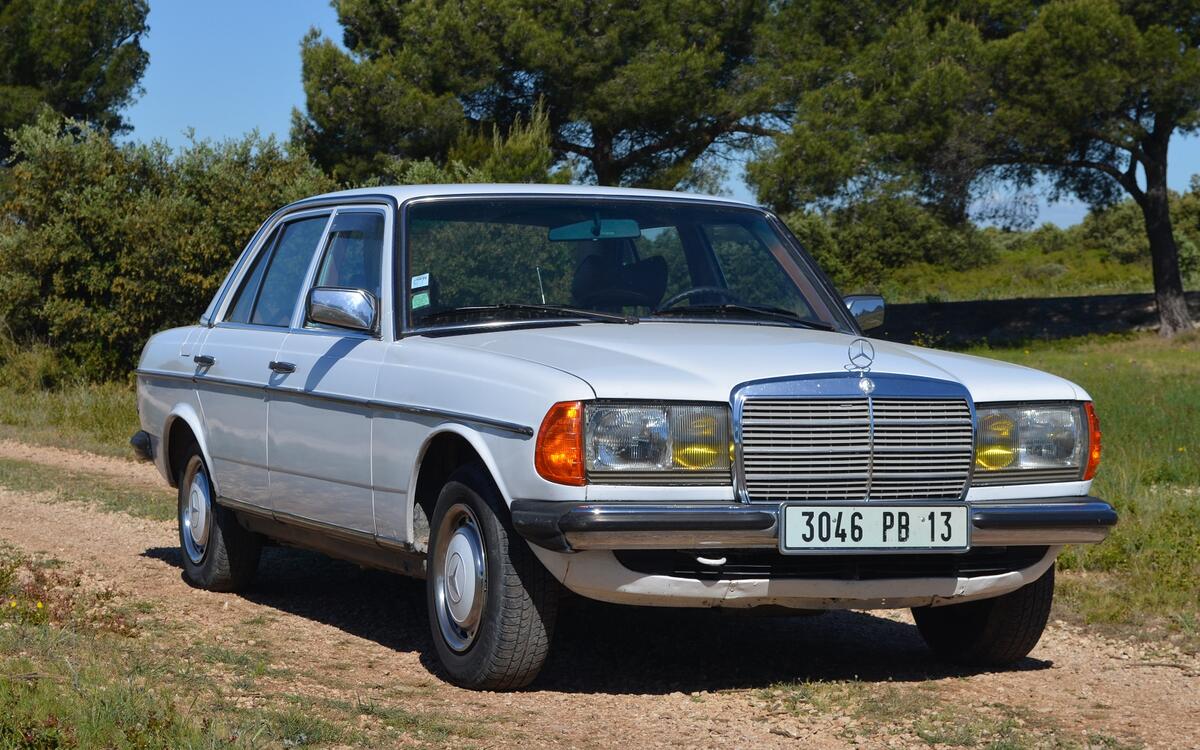 Slide of
Slide of
You’re more likely to find a vintage Mercedes-Benz in the Sahara than at a mall in Stuttgart.
Models like the W115, the W123 and the W124 enjoy a reputation for Swiss watch-like reliability matched only by other common desert dwellers like the Toyota Hilux and the Peugeot 504. They come from an era when Mercedes designed cars to a precise standard, not to a price point set in response to a growing list of competitors. They’re overbuilt to a degree that defies modern beliefs.
Here, we explore some of the best over-engineered Mercedes models:
 Slide of
Slide of
W114/W115 (1968)
Mercedes’ research and development department began working on the W114/W115 models (also called Stroke Eight) in 1961. From the start, the design brief called for an all-new standalone model that shared no major body or chassis parts with other members of the line-up. It needed to handle better than its predecessors without sacrificing ride quality and it had to be even more reliable. Buyers already expected a high degree of dependability from a Mercedes.
At launch, the portfolio included a quartet of four-cylinder-powered models grouped under the W115 designation and a pair of six-cylinder-powered models bundled under the W114 name. Both variants earned a reputation for safety and dependability that they continue to enjoy over five decades after their introduction.
 Slide of
Slide of
The record-breaking W114
The Mercedes with the highest documented mileage is a 1976 240D. Gregorios Sachinides purchased it in 1981 with 500,000km (310,000 miles) on the clock and used it as a taxi in his home country of Greece. He also drove all around Europe to visit family members and made hundreds of trips to Serbia during the war in the Balkans to transport medicine and other essential supplies.
Sachinides changed the engine three times. In 2004, after taking his trusty 240D to 4.6 million kilometers (2.8 million miles), he gave it to the Mercedes museum in Stuttgart, Germany, and received the keys to a brand-new C200 CDI in return.
 Slide of
Slide of
C111 and C111-II (1969)
Mercedes introduced an experimental prototype named C111 (pictured) at the 1969 Frankfurt auto show. The stylish coupe used a triple-rotor Wankel engine, a technology near the zenith of its popularity in 1969, while the C111-II shown a year later received a quadruple-rotor unit rated at 350hp. Mercedes resolutely solved the Wankel’s reliability issues but it couldn’t keep fuel economy and exhaust gas emissions in check. Development work on all Wankel-related projects stopped in 1971.
No one believed Mercedes would go through the trouble of designing a gorgeous coupe with gullwing doors only to confine it to the automotive attic. The firm received blank checks from several buyers who wanted to buy a C111 regardless of cost or delay. They were sorely disappointed; the company remembers it never seriously considered mass production. The C111 remained a rolling laboratory of technology, albeit one that hadn’t said its final word yet.
 Slide of
Slide of
R107 (1971)
Mercedes envisioned the R107-generation SL as the safest convertible on the market. This was an ambitious but necessary goal in an era when the entire roadster segment faced extinction by regulation due to safety concerns, especially in key markets like the US.
Engineers began by adding crumple zones to both ends of the car and strengthening the A-pillars to protect the occupants in the event of a rollover. They also gave the SL’s cabin a wide four-spoke steering wheel, recessed switches and a padded dashboard. None of these advancements came at the expense of driving enjoyment. The R107 remained a world-class grand tourer, in part because it became the first SL to offer V8 power. The line-up later grew with a more affordable straight-six-powered model.
Mercedes made about 237,000 examples of the R107 during an 18-year production run.
 Slide of
Slide of
The early ESF prototypes (1971)
Starting in 1971, Mercedes participated in the Experimental Safety Vehicle (ESV) project launched in the US a year earlier by the National Highway Traffic Safety Administration (NHTSA). The agency asked participating companies to build a car capable of protecting its occupants in a long list of common impacts including a head-on collision against another vehicle at nearly 75mph.
Early Mercedes prototypes like the 1971 ESF 05 (pictured) met and sometimes exceeded the project’s requirements but they were ill-suited for mass production. Mercedes notes the 05 weighed approximately 50% more than a W114 250 it was largely based on. Subsequent prototypes suffered from the same problem, which also brought appalling fuel economy and lackluster performance.
 Slide of
Slide of
W116 (1972)
The W116 introduced in 1972 became the first model series officially called S-Class. The market looked much different in the early 1970s than it does in 2018. Audi’s first A8 was over 20 years away, BMW had barely started developing the 7 Series and Lexus didn’t exist yet. Rolls-Royce and Jaguar models focused more on tradition than on innovation, as did Mercedes’ own 600. The S-Class truly was in a class of one.
Its innovations included an anti-dive front suspension, wrap-around turn signals visible from all sides, deflectors on the A-pillars to keep the side windows clear in a rain storm and dirt-repellent rear lights. Cruise control became optional in 1975 and ABS – which Mercedes co-developed with Bosch – arrived towards the end of 1978.
 Slide of
Slide of
The later ESF prototypes (1975)
Mercedes deviated from the NHTSA’s ESV regulations and set its own internal guidelines that focused on crash-worthiness between 30 and 50mph. The company noted the W116-based ESF 24 (pictured) shown in 1974 represented the best compromise between ESVs and production models. It weighed just 10% more than a standard W116 and it looked nearly stock yet it could keep its passengers safe in a front-end collision against a fixed barrier at 40mph.
None of the ESF prototypes made the leap to production. The knowledge gathered during the program later helped Mercedes design head restraints for front and rear occupants, three-point inertia-reel seatbelts and belt tensioners, among other safety features.
 Slide of
Slide of
W116 6.9 (1975)
Mercedes offered two flagship models in the 1970s. Production of the 600 limousine introduced in 1963 continued discreetly, though the model was largely aimed at chauffeur-driven buyers seeking traditional, money-no-object luxury. The list of owners included singers like Eric Clapton and John Lennon and heads of states such as Josip Broz Tito, Leonid Brezhnev and Mao Zedong. Pablo Escobar and James Hunt each owned one, too.
The 450 SEL 6.9 was a different type of flagship. It catered to motorists who preferred a modern, state-of-the-art sedan they could drive themselves. As its name implied, it received a 6.9-liter V8 engine rated at 286hp, a supercar-like output in the middle of the 1970s. The 6.9 came standard with a self-leveling suspension (a first for a regular-production Mercedes), air conditioning and headlight wipers. It cost twice as much as a 350 SE and it posted container ship-like fuel economy figures but that didn’t stop buyers from ordering 7380 examples over a production run that lasted four and a half years.
 Slide of
Slide of
C111-IID (1976)
Efforts to find an alternative to gasoline-powered engines picked up steam in the wake of the first oil crisis. Mercedes focused its attention on diesel, a promising technology it had been dabbling in for decades. The naturally-aspirated five-cylinder diesel in the W115 300D made 80hp. Engineers turbocharged it and added an intercooler to extract a stout 190hp from it. The modifications included adding oil jets to cool the pistons.
Instead of building a super-quick family-hauler, Mercedes installed the engine in the C111-II. And, to prove its point, it promptly sent the C111-IID to Nardo, Italy, where it set 16 world records over the course of 60 hours. The list included new endurance records for distances of 5000 and 10,000 kilometers (3100 and 6200 miles, respectively) and 10,000 miles (16,000 kilometers) set at an average speed of 156mph (252kmh). Again, enthusiasts asked Mercedes for a production model. And, again, the C111-IID remained at the prototype stage.
Mercedes nonetheless brought its turbodiesel technology to mass production in 1978 under the hood of the W116 300SD, a model sold exclusively in the US and Canada. The five-cylinder was de-tuned to 115hp in its initial state of tune. Evolutions of this OM617 engine later equipped the W123 and W126 models.
 Slide of
Slide of
W123 (1976)
W123 development started in 1968, the same year Mercedes launched the model’s predecessor. The brand’s archives department notes the design brief called for maximum safety, exemplary comfort and – an attribute all too often forgotten in 2018 – ease of maintenance. Designers experimented with showy, extravagant prototypes but ultimately decided the timing wasn’t right for a styling revolution. They instead settled for classic, understated lines.
The press and the public praised the W123’s comfort, handling and wide palette of engines. Though it wasn’t a limited-edition model by any means, the W123 was sold out during its first year of production. This delighted early buyers who could sell a year-old car for the price of a new one.
Mercedes made 2.7 million examples of the W123 during a 10-year production run. That figure includes short- and long-wheelbase four-door models, coupes, station wagons (a first for Mercedes) and bare chassis transformed into hearses and ambulances by exterior coachbuilders like Binz.
 Slide of
Slide of
From London to Sydney (1977)
In 1977, intrepid British pilot Andrew Cowan won the grueling London-Sydney Rally behind the wheel of a 280E. Anthony Fowkes drove a second, identical 280E to a second-place finish. Both cars were based on the regular-production model and upgraded with 15in wheels, stronger suspension components and sand plates in lieu of bumpers. Mercedes also added a four-speed manual transmission borrowed from the W116 and tweaked the ignition system to cope with low-octane fuel.
 Slide of
Slide of
C111-III and C111-IV (1978)
Mercedes saw an immense amount of potential in the C111-IID’s engine. In early 1977, a small team within the brand’s research and development department built a brand-new prototype called C111-III that looked decidedly more like a race car than a street-legal sports car. It had a longer wheelbase than the C111-IID, a narrower track, concealed wheels and a more aerodynamic design. In a surprising display of foresight, Mercedes also added a telemetry system that automatically recorded data about each run.
Equipped with a 230hp five-cylinder turbodiesel engine, the C111-III (pictured) set nine world records at Nardo including driving 1000 miles (1600 kilometers) at an average speed of 198mph (318kmh) and driving for 12 hours at an average speed of 195mph (313kmh). Its successor, the C111-IV, relied on a 500hp V8 with 4.8 liters of displacement to reach 250mph (402kmh) on the same track.
 Slide of
Slide of
W460 (1979)
In the early 1970s, Mercedes parent company Daimler-Benz enlisted the help of Steyr-Daimler-Puch to design a Land Rover-like off-roader. The project aimed to condense Mercedes’ build quality and reliability into a package capable of taming the Alps. Named G-Class, the model arrived in 1979.
The G’s target audience initially included farmers, motorists living in the countryside and adventurers. It quickly grew to include the armed forces in dozens of countries around the world, the Vatican and ritzy Hollywood-dwelling socialites.
 Slide of
Slide of
W126 (1979)
It didn’t take long for the press and the public to see the advancements packed into the W126 S-Class. Its front and rear bumpers were neatly integrated into the overall design instead of merely bolted onto the body, a styling cue which broke with Mercedes tradition while giving the flagship model a considerably more modern look. The brand noted the new bumpers also improved pedestrian safety.
Mercedes added an airbag for the driver and seatbelt tensioners to the W126 at the 1981 Geneva auto show. The driver-side airbag became optional on every Mercedes model in 1982 and standard across the board in 1992. Seatbelt tensioners became standard on all Mercedes models in 1984.
 Slide of
Slide of
W201 (1982)
Mercedes remembers the most challenging part of developing the W201 190 was achieving an acceptable level of safety in a car much smaller and lighter than the other members of its line-up. To that end, it designed a multi-link independent rear suspension that later became the point of reference for all of the brand’s designs regardless of size or segment. The W201 also inaugurated four- and five-cylinder diesel engines that were more powerful and significantly quieter than the ones found in the W123.
 Slide of
Slide of
W124 (1984)
The W124 represented another leap forward in engineering. Mercedes relied on weight-saving techniques and aerodynamic design to improve fuel efficiency across the board and it incorporated digital crash computations into the development process for the first time. Over the years, the line-up in Europe included relatively basic models like the 200 (which came with a carbureted four-cylinder engine) and the 200D and full-fat variants like the 500E, which received a V8 also found in the R129 SL and the W140 S-Class.
Mercedes boasted the W124’s single, eccentric-sweep front wiper cleared 86 percent of the windshield. The model inaugurated Mercedes’ 4Matic all-wheel drive system at the 1985 Frankfurt auto show and received six-cylinder engines with four valves per cylinders in 1989.
The W124 spawned a convertible in 1991 and became the first E-Class when Mercedes introduced a new naming system in 1993. Mercedes began phasing the model out in 1995 and ended production when it built the last convertible in 1997.
 Slide of
Slide of
R129 (1989)
Mercedes began developing the R129 SL in 1984, over a decade after introducing the R107 model. Built on a modified W124 platform, the SL stood out with lines that followed the brand’s then-current design language and the technology that looked well into the 1990s.
Mercedes notably took advantage of advancements in sensor technology to develop a roll bar that deployed in 0.3sec if it detected the car was about to roll over. The brand also made the seat frames out of several types of magnesium alloys for extra strength and integrated the seatbelt mechanism into the seat.
 Slide of
Slide of
The 18-cylinder that never was
Mercedes considered building an engine with 18 cylinders arranged in a W configuration. The blueprints outlined an eight-liter W18 made by fusing three 2.6-liter straight-six engines together. Engineers envisioned a basic W18 with two valves per cylinder and 490hp to power limousines and a 680hp variant with five valves per cylinder for a sports car. If built, it would have instantly earned a spot in the pantheon of spectacular over-engineering. No one ever heard it start, though.
Members of Mercedes’ board flatly rejected the project so engineers never built a single prototype. They saw upsizing as a trend that needed to be checked rather than cultivated. They justified their decision by pointing out there was no need for something as grandiose as an 18-cylinder engine because the V12 developed for the S-Class and the SL met all performance requirements.
 Slide of
Slide of
The 1990s
Mercedes’ reputation took a hit during the 1990s. Broadly speaking, the brand’s cars took a step back in terms of build quality and reliability. They felt less solid than their predecessors, they suffered from more serious rust problems (in an era when most auto-makers were making progress in rust-proofing) and they were sometimes plagued by shoddy electronics. Its 3.5-liter turbodiesel engine had a monstrous appetite for connecting rods; the original A-Class nearly became the Chevrolet Corvair of the 1990s. Mercedes nonetheless kept innovating and side airbags joined the E-Class’ list of options in 1995.
Historians attribute the hiccup to decision-makers getting caught off-guard by Japanese luxury brands like Lexus, Infiniti and Acura. They reduced development and production costs to stay competitive, especially on the lucrative American market, while simultaneously building cars with an ever-increasing level of expensive and complex electronic functions. Merging with Chrysler in 1998 ate up a tremendous amount of resources, too.
The W211 E-Class of 2002 was plagued with problems, but Mercedes ruthlessly focused on them when launching the the face-lifted version in 2006 and, for the most part, has been flying high since.
 Slide of
Slide of
Mercedes’ over-engineered models today (2018 and beyond)
In 2018, most of the cars made during Mercedes’ over-engineering era have transitioned into desirable – and sometimes valuable – classics. Collectors pay more for coupe and cabriolet models so the four-doors remain reasonably affordable. Regardless of body style, a classic Mercedes that’s received proper maintenance is reliable enough to use on a regular basis, even on longer trips.
Mercedes' R&D department used to be second to none
Advertisement












































